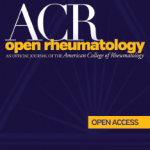Improvements for Readers
The journal will continue to provide a high-quality reader experience, enhanced by two major improvements over the past five years—inclusion of clinical images and a journal club.
Dr. Yelin and Ms. Murphy explain that clinical images provide valuable information to clinicians who may encounter patients whose conditions cause symptoms like those the images depict and who need to make correct diagnoses.
Print journals don’t have as much space for clinical images. “Because ACROR is [Web based], we can make many more images available to the rheumatology community,” Dr. Katz says.
ACROR’s monthly journal club for rheumatology fellows involves program directors who nominate fellows to critique selected articles and to publish a commentary in the peer-reviewed journal. Other fellows may comment on the critiques.
Dr. Katz credits ACROR Senior Editor Bruce N. Cronstein, MD, Dr. Paul Esserman Professor of Medicine, NYU Langone, New York, with the idea of starting the journal club, which she described as a two-fer for trainees, who get experience both writing and reading articles.
The club is also a way to interest young researchers in rheumatology, says Dr. Yelin.
A Trend Toward Open Access
As an entirely open access journal, ACROR started ahead of a major trend, Dr. Katz says. She and Dr. Yelin were co-editors of AC&R when it and other journals began publishing certain articles online before print, via open access. Now many funders require researchers publish the work they support via open access, she notes.
This trend is especially prevalent among government funders, Dr. Yelin and Ms. Murphy point out.
“Government funders want more immediate access. There’s also an equity issue for researchers in less developed countries,” adds Ms. Murphy. “The push for open access is a global movement.”
Strong editors, staying ahead of a trend and offering readers valuable improvements, have given ACROR a strong start. “Our mission during the next phase of ACROR is to clearly define the goals of the journal, increase its visibility and make it an attractive venue for authors to publish top research in rheumatology,” says Dr. Sawalha.
“The goal is to continue to publish all types of high-quality rheumatology research and expand options for publication in ACR-sponsored journals. I hope ACR Open Rheumatology will continue to grow,” Dr. Katz concludes.
Interested in becoming the next editor of ACROR? ACR/ARP members who are considering applying for the position should submit a nonbinding letter of intent by May 15, 2023, to Kimberly Murphy at [email protected]. For details, visit https://www.rheumatology.org/acr-open-rheumatology-journal.

